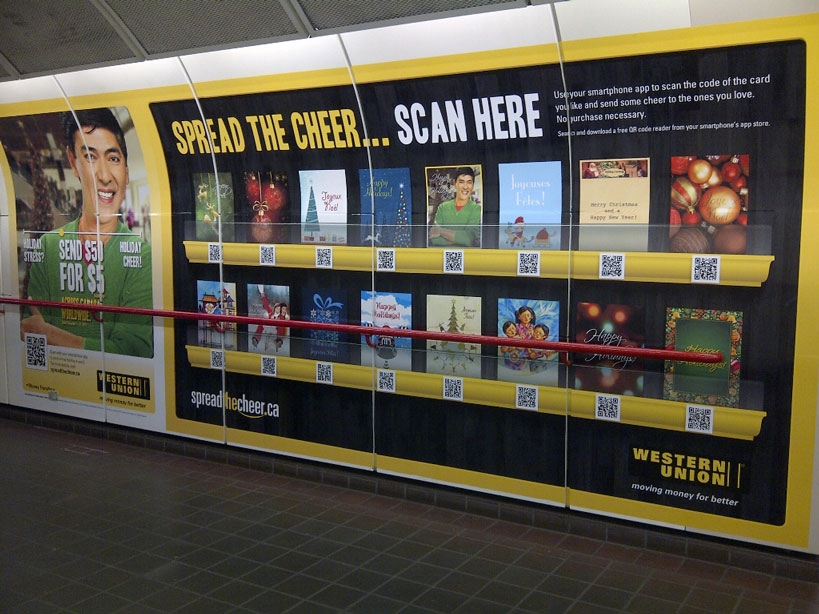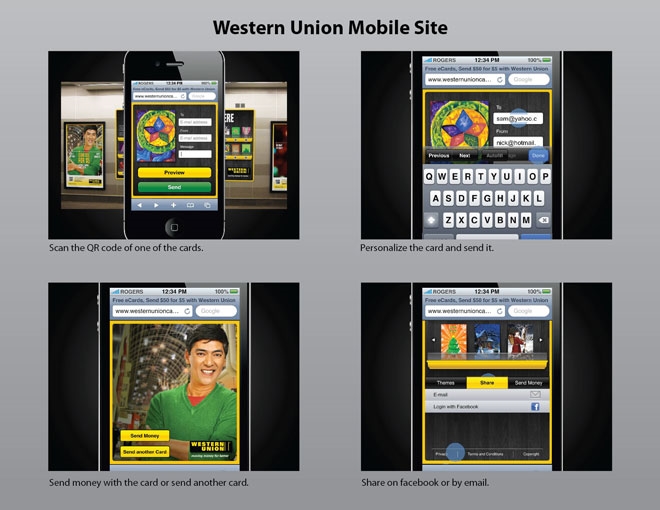Western Union 5 for 50
Events, Seasonal and Short-Term (BRONZE)
Client Credits: Western Union Canada
Joycelyn David, Marketing Director
Agency Credits: AV Communications
Marvi Yap, Partner
Anna Maramba, Partner
Loiee Pangan, Creative Director
Zeno Lam, Creative Director
Caspar Sun, Account Manager
Joyce Lau, Media Specialist
Crossover Notes:
All winning cases contain lessons that cross over from one case to another. David Rutherford has been identifying these as Crossover Notes since CASSIES 1997. The full set for CASSIES 2013 can be downloaded from the Case Library section at www.cassies.ca.
Crossover Note 2. Brand Truths.
Crossover Note 3. Core Equity versus Price & Promotion.
Crossover Note 11. The Eureka Insight.
To see creative, click on the links that are embedded in the case.
Section I — BASIC INFORMATION
| Business Results Period (Consecutive Months): | December 1, 2011 – December 31, 2011 |
| Start of Advertising/Communication Effort: | December 1, 2011 |
| Base Period as a Benchmark: | December 2010 |
Section II — SITUATION ANALYSIS
a) Overall Assessment
The holiday season is synonymous with gift-giving. For money transfer companies, this time of the year is busiest and also the most competitive. With service to over 200 countries, Western Union is the dominant player in Canada. However, there are over thirty major competitors (retail), along with fast-rising online operators. Speed, safety and convenience are paramount to our product offering, and Western Union is the only provider to offer ubiquitous service across retail, online, telephone mobile-based apps through agents like Scotiabank, Walmart, Metro and Money Mart.
For people who are far from their loved ones, sending money as a gift is a popular and convenient choice. For the 2011 holiday season, Western Union Canada announced a discounted fee of $5 to send $50 worldwide. However, even with this discount from the previous $8 levle, this was still not the lowest price in the market. Competition was offering transfer fees between $2 to $10 for sending $50. In other words, simply announcing the $5 price would not make competitive users rush to Western Union’s side.
b) Resulting Business Objectives
> Achieve an incremental 10% lift in sales vs. year-ago for the campaign period
> Deliver 50,000+ visits to the website in 4 weeks.
c) Annual Media Budget
$500,000 – $1 million
d) Geographic Area
All of Canada
Section III — STRATEGIC THINKING
a) Analysis and Insight
Target Market: Globally connected Canadians sending money around the world (immigrant communities)
Situation Analysis: Being far away from relatives in their country of origin, sending money to them during the holiday season is a popular choice. The price promotion is a good business move; however, it is hardly a differentiation from competition. [Crossover Note 2]
The challenge: How does one rise above the clutter during this peak season of advertising? How can one turn a simple pricing promotion into something exciting, fresh, relevant and impactful?
The solution: Create buzz by staying away from directly announcing the price off. [Crossover Note 3]
Insight: People far away from loved ones often send holiday cards by mail or e-holiday cards as a way to keep them close in spirit. Before the internet people would enclose money in holiday cards and send them by mail. Nowadays, people send money electronically. We saw the connection of sending money and holiday cards. This was our eureka moment… leverage this connection!…. and incorporate a twist to make it even more exciting. [Crossover Note 11]
b) Communication Strategy
The big idea: Why not combine the traditional way of sending money inside a holiday card with interactive, engaging, cutting edge technology?
The unique approach:
Create VIRTUAL holiday card stores in transit stations, street cars, buses and on the walls of shopping centres. People would then scan the QR code at the bottom of the card. This would take them to a micro-site. And this would enable them to send the holiday cards electronically.
After the e-card was sent, a message would invite people to send $50 for $5 with a number of convenient sending options. This gave birth to the theme SPREAD THE CHEER.
So while the competition was busy announcing discounts and free trips, the market was busy scanning QR codes and sending e-cards and money to loved ones.


Section IV — KEY EXECUTIONAL ELEMENTS
a)Media Used
PRIMARY:
Out of home: Transit vehicles, Transit Stations, Malls frequented by immigrant communities, Microsite
SECONDARY:
Print, TV, Ethnic stores
b)Creative Discussion
The overiding strategy of the campaign was to bring a familiar activity in an unusual setting. In this case, the market is used to sending holiday cards to relatives and friends far away. But to send them while waiting for their bus, shopping in the mall, or riding a street car is unusual to say the least.
To resonate even more with the target market, some of these giant holiday cards in the virtual card stores were created with a cultural theme. Example: cards depicting a typical holiday scene in the Philippines (Western Union’s top money receiving country) were created to appeal to Filipinos, and bring feelings of nostalgia. (See image below.)
c)Media Discussion
The overriding strategy in media was to go where the immigrant communities are and stand out.
These Virtual Card Stores were placed in malls and public transit stations with high ethnic foot traffic.
In some public vehicles, we bought non-traditional spaces such as the ceiling of the street car to create added attention. Carollers were hired to go around malls and spread the cheer by singing Christmas carols with the virtual card stores as backdrop.
Supplementary media where used such as announcements in ethnic print media, TV and ethnic stores. Community organizations were likewise tapped to spread the promotion.



Section V — BUSINESS RESULTS
a) Sales/Share Results
At the end of the month long campaign, our key performance indicators told the story.
The campaign achieved an incremental 30% lift vs. 10% growth objective. This was double the growth of the business in the same period of December 2010.
The campaign site delivered 132,514 pages visits, 165% achievement to the goal of 50,000. Within this, 81% of visitors were new. The QR Code delivered 4,471 scans, average of 150 per day.
These results were achieved despite a marketing spend for this campaign period at just 2% of revenue.
b) Consumption/ Usage Results
c) Other Pertinent Results
d) Return on Investment
Section VI — CAUSE & EFFECT BETWEEN ADVERTISING AND RESULTS
a)General Discussion
December is a peak time to send money. There is a natural uptrend in the money transfer category in general, and promotions during this period do help maintain growth in a competitive space.
However, this is the first time that the overall lift was 3 times higher than objective.
b)Excluding Other Factors
Spending Levels:
As noted, the marketing spend versus revenue for this campaign period was less than 2%.
Pricing:
Western Union has a premium price compared to many of itscompetitors. As a result, the discounted offer was still higher than what some of the competition was offering.
The price offer was to send $50 for $5. Competitors were offering $2 to $10 to send $50.
Distribution Changes:
The company operates through agents or independent businesses. In 2011, there were no major sign ups of agent networks, there was normal agent churn. In Q4 of 2011, (the period leading up to the promotion and during the promotion month) the agent count grew less than 3% in Canada.
Unusual Promotional Activity:
There were no high value incentives to sway the market towards Western Union. It was purely engagement in a microsite that didnt promise any incentives or prizes.
Other Potential Causes:
One may argue that the $3 decrease in price from the original transfer fee was enough to ensure success. This conclusion may be logical to some industries, however this is hardly the case in the extremely competitive money transfer industry.
Being a premium brand, Western Union fees are at a premium compared to its over 20 major competitors in the money transfer business. This does not count the banks, and other online operators offering other options of sending money such as wire transfers, email money transfer, etc. The tendency of new entrants to the market and value-driven competitors is to issue deep penetration pricing to lure new consumers, thus, price reductions is commonplace to the category and a limited differentiation in the marketplace.
